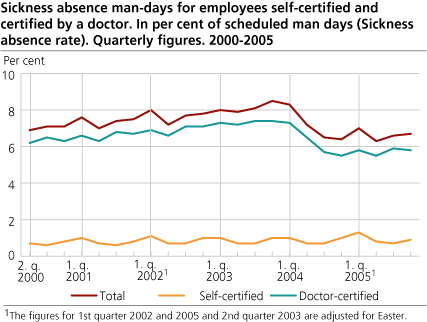Content
Published:
This is an archived release.
Increased sickness absence
The sickness absence rate increased from 6.4 in the fourth quarter of 2004 to 6.7 per cent in the fourth quarter of 2005. Absence certified by a doctor increased from 5.5 to 5.8 per cent, and the self-certified absence decreased from 1.0 to 0.9 per cent
The rise of sickness absence from 6.4 to 6.7 per cent, corresponds to an increase of 4.9 per cent. For men the increase was 2.8 per cent and for females 6.6 per cent. The sickness absence was 10.0 per cent lower than it was in the fourth quarter of 2001, the year when the agreement on an inclusive labour market was implemented.
Increase in most larger industries
Among the larger industries, the growth in sickness absence was largest in health and social work where the increase was 7.8 per cent. The growth of sickness absence was also relatively strong in public administration and defence that increased by 5.8 per cent, as well as in domestic trade, hotels and restaurants where the increase was 5.2 per cent.
Some of the larger industries had a growth of sickness absence being well below the average level of 4.9 per cent. The growth was 1.6 per cent in financial intermediation, 2.0 per cent in construction, and 3.0 per cent in manufacturing.
Increase in all counties
The sickness absence grew in all counties. The increase was largest in Finnmark with 12.4 per cent increase, Nordland with 10.0 percent, and Nord-Trøndelag with 9.9 per cent. The counties having smallest growth were Aust-Agder with 0.7 per cent increase, Vestfold with 0.9 per cent, and Oslo that increased by 2.2 per cent.
The sickness absence level was still highest in Finnmark with 9.0 per cent and lowest in Rogaland with 5.4 per cent.
Increase in the proportion of long - lasting absences
Sickness absence lasting more than 31 days, added up to 61.7 per cent of the sickness absence in the fourth quarter of 2005. This was an increase from 60.0 per cent in the fourth quarter of 2004.
Strongest increase in Local government
In local government, the sickness absence increased by 8.1 per cent from the fourth quarter of 2004 to the fourth quarter of 2005. At the same time, the sickness absence rose by 5.5 per cent in the central government (including the state hospitals) and 3.7 per cent in private sector and public enterprises. The state hospitals were the major contributors to the growth in central government.
The following results are based on data on sickness absence certified by a doctor, as the survey on self-certified absence does not contain data on sickness absence by age.
Rise in age groups between 30 and 60 years old
The sickness absence increased in most age groups, and most noticeably among females between 30 and 60 years old.
The sickness absence rate measures the proportion of scheduled man-days lost due to own sickness. The statistics do not cover self-employed persons.
The sickness absence statistics are produced in cooperation with the National Insurance Administration (RTV).
Tables:
- Table 1 Sickness absence man-days for employees self-certified and certified by a doctor. In per cent of scheduled man-days (Sickness absence rate). Quarterly figures. 2000-2005
- Table 2 Sickness absence man-days for employees self-certified and certified by a doctor, by sex. In per cent of scheduled man-days (Sickness absence rate). Quarterly figures. 2000-2005
- Table 3 Sickness absence man-days for employees self-certified and certified by a doctor, by industry and type of sickness absence. In per cent of scheduled man days (Sickness absence rate). Quarterly figures. 2000-2005
Contact
-
Arbeidsmarked og lønn
E-mail: arbeidsmarked@ssb.no
-
Unn H. Høydahl
E-mail: unnh.hoydahl@ssb.no
tel.: (+47) 40 90 23 77

